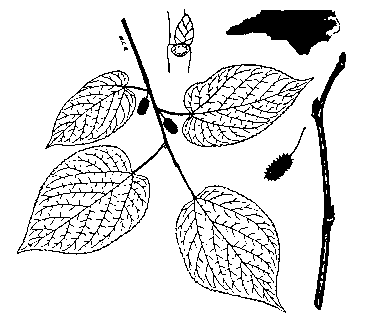|
Red
Mulberry
(Morus
rubra L.)
|
|
| |
 |
|
| |
Red
mulberry grows throughout North Carolina. It grows best on the
rich, red soils of the lower and middle sections of the state
but is not abundant in any region. It commonly is called mulberry,
because there are no other native mulberry species.
Red mulberry leaves are alternate, thin, rounded or somewhat heart-shaped,
toothed, pointed, 3 to 5 inches long, rough-hairy above and soft-hairy
beneath. Leaves from juvenile tissue (early branches) are mitten-shaped
or variously lobed (two to three lobes), while leaves from mature
tissue (older, or upper-crown branches) are not lobed.
The fruit resembles that of blackberry. Fruits are red when immature,
turning deep purple when ripe, usually during late June or July.
Berries are1 to 11/2 inches long, sweet, juicy and edible.
The red mulberry is a small tree, usually 20 to 30 feet tall,
with trunk diameters rarely larger than 2 feet. It usually has
a short trunk and a dense, spreading crown.
The bark is dark brown with a reddish tinge. It is scaly, with
the tips of the scales curling and peeling off. The dark brown
wood is light and soft and, although it is not strong, it is quite
durable.
Red mullbury is used for fencing and barrels. Red mulberry is
a small, rather scarce tree, and therefore is not considered as
an important commercial tree. The berry is a favorite food for
gray squirrels, wild turkeys and many songbirds. |
|
|

